Blog & Articles
Your ultimate ressource for the creator economy
Methodology & Rankings
About Favikon, rankings, tools & much more.
Insights
The recipe behind Favikon's viral & coveted rankings.
Free tools to power your influencer marketing workflows.
See Favikon users' success stories.
Get access to all Favikon rankings.
Become a Partner
Become an Affiliate
About the team behind Favikon
The place to talk creator economy, together


Featured Rankings

Here is the Top 50 Rising Video Creators on LinkedIn. Video is quickly becoming the platform’s most powerful format, with creators gaining more reach and engagement than ever. As Gen Z grows its presence and tools like BrandLink and Thought Leader Ads support content creation, LinkedIn is doubling down on video. This ranking, made in partnership with OpusClip, celebrates the creators leading this shift and aims to inspire anyone ready to start sharing through video.

Here is the Top 50 Rising Video Creators on LinkedIn. Video is quickly becoming the platform’s most powerful format, with creators gaining more reach and engagement than ever. As Gen Z grows its presence and tools like BrandLink and Thought Leader Ads support content creation, LinkedIn is doubling down on video. This ranking, made in partnership with OpusClip, celebrates the creators leading this shift and aims to inspire anyone ready to start sharing through video.
The B2B LinkedIn Strategy Driving 50% of Pipeline For an $8M ARR SaaS
Discover how a fast-growing SaaS company built a LinkedIn strategy that now drives half of its sales pipeline. This breakdown reveals practical tactics any B2B team can use to boost visibility and revenue.
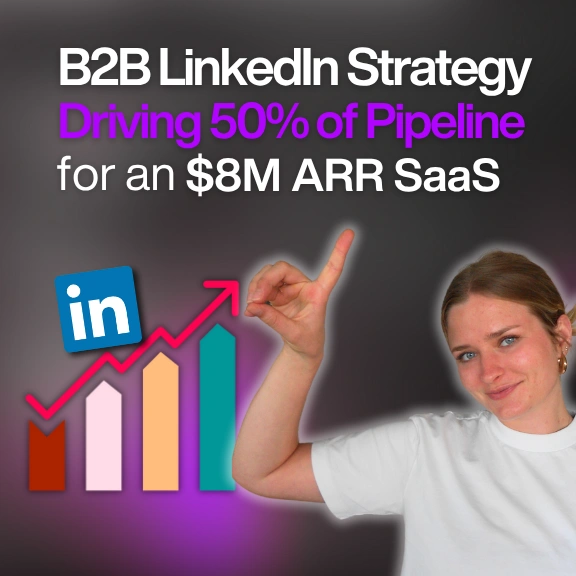


Megan Mahoney is an influencer marketer who uses data and real-world case studies to uncover what actually drives results in influencer campaigns. With a background in content marketing and over a decade of experience helping brands grow through strategy and storytelling, she brings a thoughtful perspective to creator partnerships and is deeply engaged in the evolving creator economy.
Check Brand DealsThe B2B LinkedIn Strategy Driving 50% of Pipeline For an $8M ARR SaaS
Storylane is a B2B SaaS company that sells demo software, and VP of Marketing, Madhav Bhandari, stated that over 50% of their pipeline comes from LinkedIn:
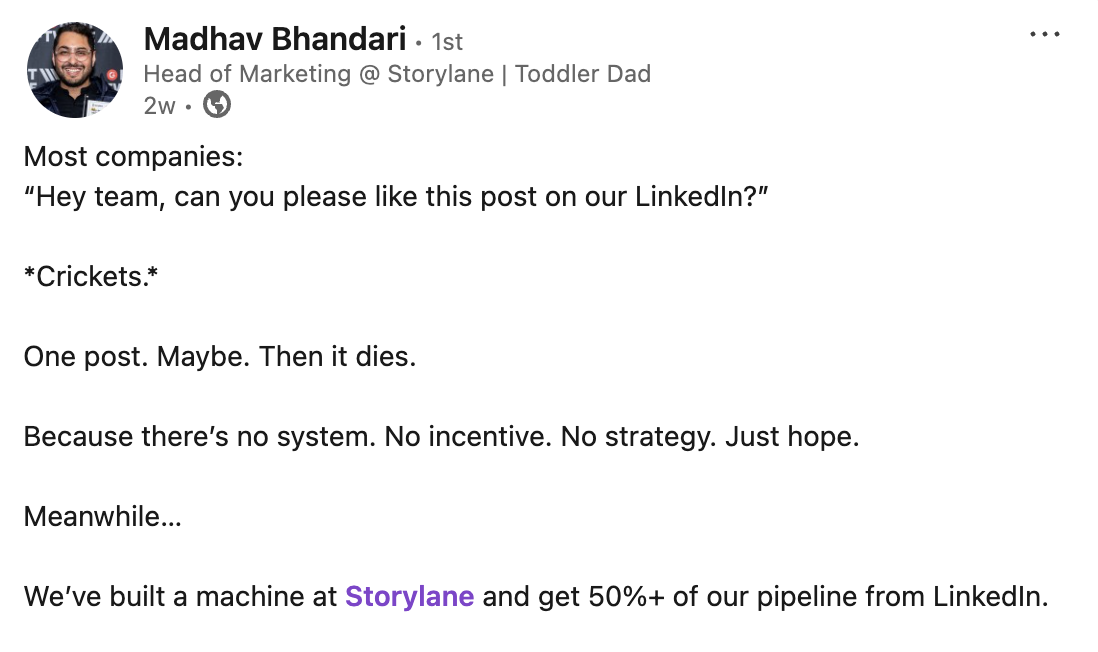
Despite following typical LinkedIn marketing best practice advice (i.e., “post more quality content and ask employees to engage”), most B2B social media managers usually run into two problems:
- Low company page engagement: The algorithm naturally gives less reach to company pages. And, people engage with people – not brands. So most branded content never takes off.
- Poor employee participation: Most companies ask their employees to share and engage on social media, but many employees don’t feel comfortable participating on social media or consider it a lower priority than their other work.
In this post, we’ll analyze how Storylane navigated and overcame these challenges to build a LinkedIn marketing strategy that drives the majority of their revenue.
Storylane’s Broader Approach to LinkedIn Marketing
Many B2B social media marketers set a goal to grow their brand’s LinkedIn profile.
Yet branded LinkedIn profiles generally receive less reach than personal profiles.
And, people enjoy engaging with other people, not faceless brands.
In fact, I looked up Storylane’s company profile in Favikon, and their engagement metrics aren’t remarkable.
Here are some stats:
- Followers: 19,200 (mid to below average general company page)
- Average Engagement: 60 (mid to below average of general company page)
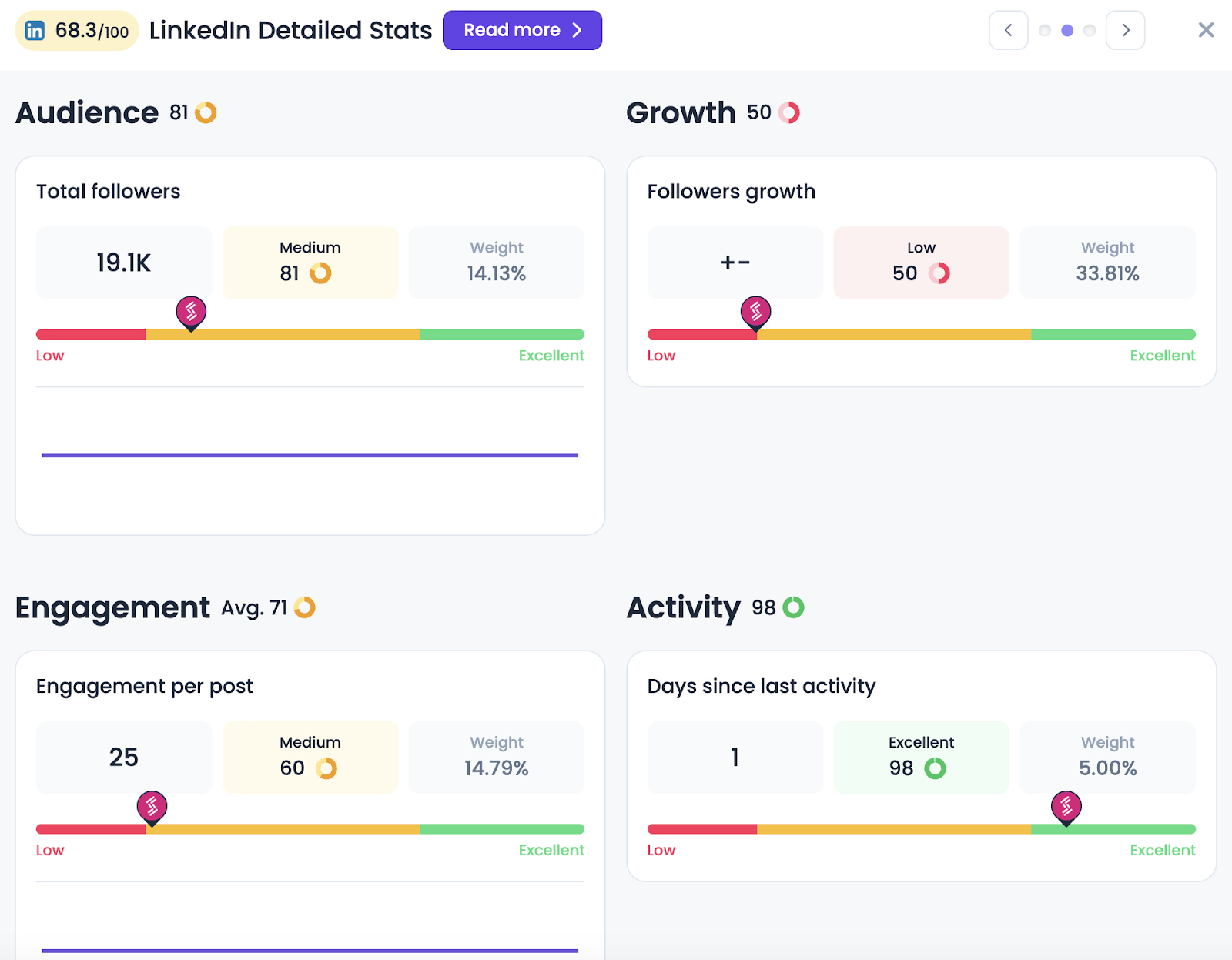
However, these statistics are more a reflection of Storylane's team's realization that the LinkedIn company page is one of the lowest-leverage opportunities.
Instead, they made the wise decision to invest in individual people to promote the brand on LinkedIn.
Here are the three prongs of Storylane’s LinkedIn marketing strategy:
- Employees: Executives and employees in the marketing, sales, and CS departments
- Creators: Industry experts with engaged LinkedIn audiences
- Customers: Through contests like DemoDundies, customers are incentivized to share their demos made with Storylane
We looked at all of the engagement generated by LinkedIn posts that tagged Storylane, and here’s an overview of the engagement breakdown:
(Note: Customer led content was not included in this calculation as customers didn’t necessarily tag Storylane. Instead they often tagged used specific hashtags, like #demodundies.)

In this post, we’ll break down how Storylane navigated each of these three pillars and share some of the tips their team has mentioned in podcasts and LinkedIn posts.
Step 1: LinkedIn Employee Advocacy
Employee advocacy is a growth strategy that encourages employees to either publish content on behalf of the company on their own profile or engage with company or other employees’ content.
Storylane’s VP of Marketing, Madhav Bhandari, shared on the Ahrefs podcast that employee advocacy is the LinkedIn growth strategy Madhav recommends brands first implement.
“If you want to grow on LinkedIn, you have to start from your team members,” Bhandari stated.
“Everybody knows that company profiles don't have a lot of reach. Personal profiles have a lot more reach. So you need to leverage that to be able to get that initial spark to your brand.”
To give you an overview of their employee advocacy program’s success, here are some statistics I gathered in Favikon:
- 17 active employees (from a total of approximately 50 employees)
- 566 posts from these 17 employees
- 46,700 total engagements
- 3.6M cumulative views
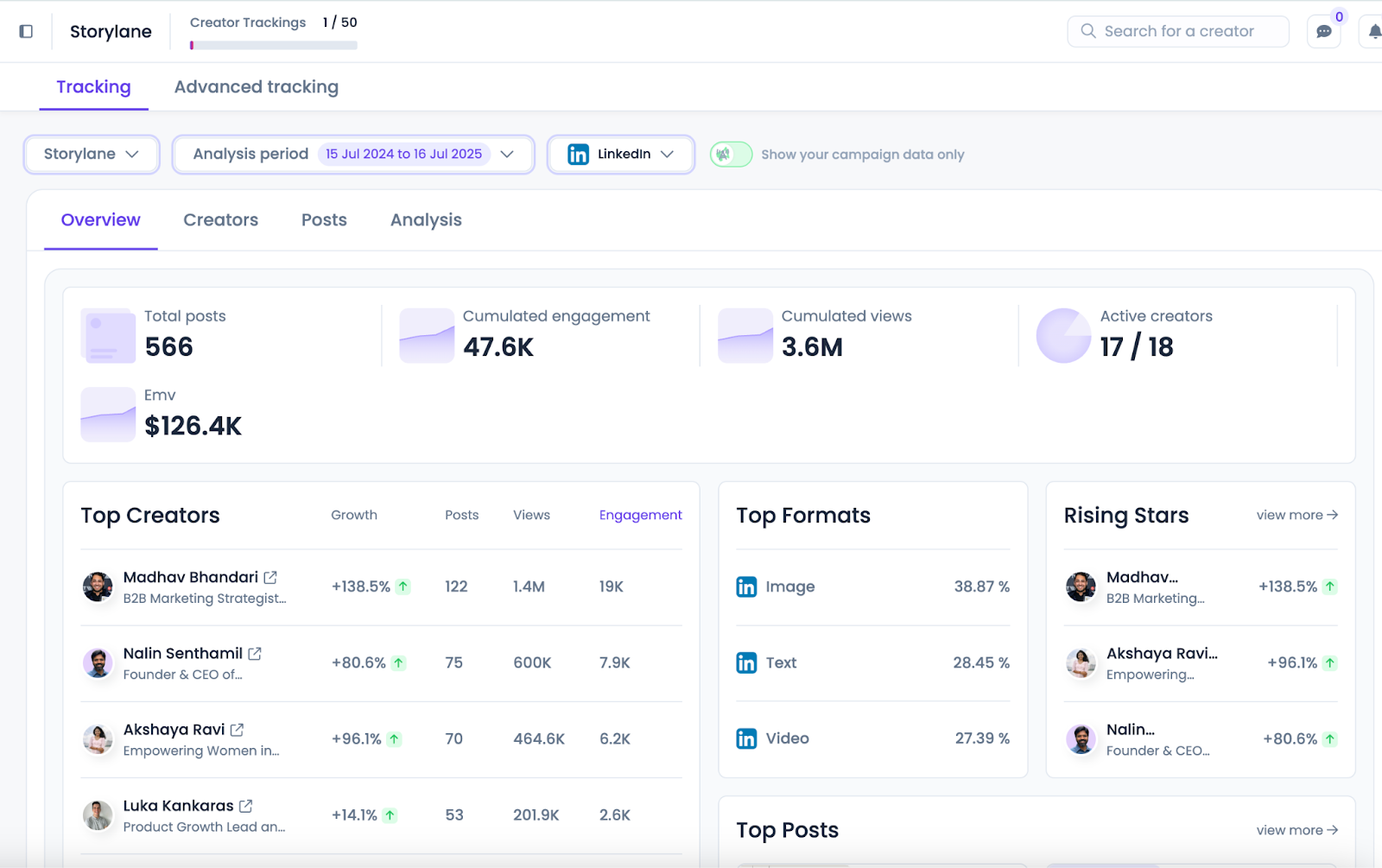
Looking under the “Analysis” tab in Favikon, you can see that the total number of employee posts (along with engagement) has grown significantly over the past year:
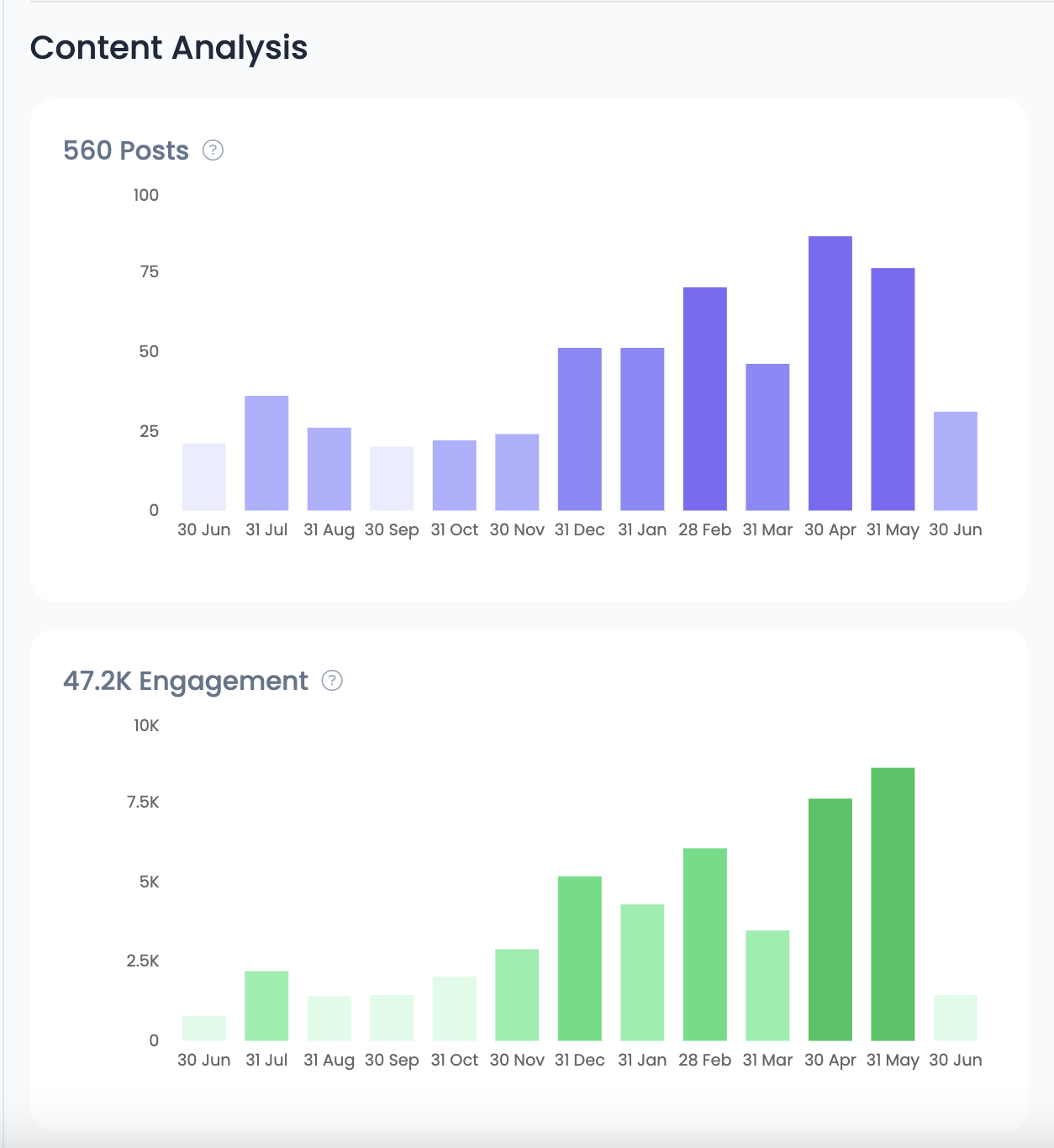
While these graphs only illustrate the employees’ total posts (not necessarily posts that involve company promotion), this is a useful metric to track because your employees are your brand’s amplification.
As your employees' following grows, your brand’s distribution opportunities also grow.
Of course, some employees may leave over time. Though if you build a culture that values employee advocacy, the overall net ROI of employee advocacy efforts should still be positive.
If you’re building an employee advocacy program, the three most important questions are:
- Who: Which employees should you include in your employee advocacy program?
- How: How do you incentivize and encourage employees to participate consistently?
- What: What were the types of posts that performed well so that you can give employees some guidelines on what to post?
We’ll break down how Storylane approached each of these questions below.




Who: Which employees were included in Storylane’s employee advocacy program?
Many SaaS companies attempt to include all employees in the advocacy program.
Yet as CMO Madhav Bhandari pointed out on the Ahrefs podcast, many employees are reluctant to post on LinkedIn.
“Some people are just not social media savvy. Some people don't want to share. Some people, they're too busy with their work.”
So, which employees should you involve in your employee advocacy program?
Bhandari’s approach is to start with:
- Leadership: Ensure key executives in marketing and sales are participating.
- Those already active on LinkedIn: Some team members will likely have a substantial following on LinkedIn. In Storylane’s case, there were 5-6 “influencer” employees whom they immediately included in the advocacy program.
Here’s what Bhandari stated in a LinkedIn post:

Once you have leadership and current company influencers involved, Bhandari recommends focusing on the following core teams to participate in employee advocacy:
- Marketing
- Sales
- Customer Support
On the Ahrefs podcast, host and CMO, Tim Soulo, raised a common objection that many marketing leaders likely consider:
“Is it really worth it to have your junior customer support rep involved in the employee advocacy program?”
Bhandari’s counterargument is that they want Storylane appearing everywhere in a prospect’s feed.
In fact, total impressions and engagement from employee posts isn’t even a primary metric Bhandari uses to measure the efficacy of their employee advocacy program.
Instead, he focuses on keeping Storylane at the top of key decision-makers' feeds.
Therefore, the goal is to eventually involve every employee who has direct touchpoints with customers and prospects in the employee advocacy program.
So a junior customer support rep?
They might have a touchpoint with an existing customer and connect with them on LinkedIn.
Therefore, that person should be involved in Storylane's employee advocacy program.
Here’s a recap of Bhandari’s approach to building an employee advocacy program:
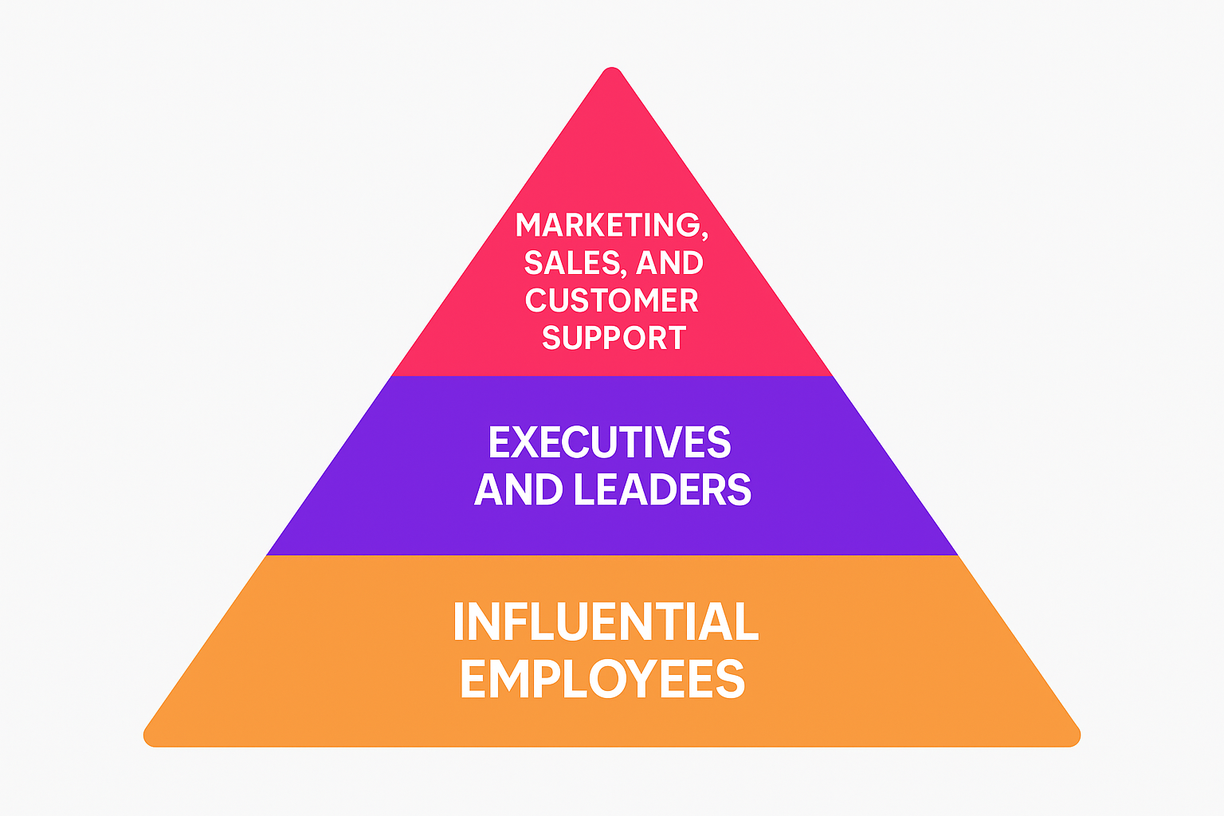
How: How do you incentivize and encourage employees to participate consistently?
The four key pillars that Storylane uses to keep employees consistently engaged are:
- Positive reinforcement
- Ghostwriting support from the team
- Fun content
- Gamification
Positive Reinforcement
Begging employees to engage or making them feel guilty doesn’t yield engagement.
Instead, Bhandari believes in positive reinforcement.
Rather than nagging employees, he starts every all-hands meeting by thanking them for LinkedIn participation – even if participation was minimal.
He also ends every all-hands meeting with “engage, engage, engage.”
This approach, combined with active participation from leadership, created a “LinkedIn-first” culture that helped their employee advocacy program take flight.
Ghostwriting Support From The Team
And speaking of leadership, you may find that not every leader feels comfortable posting on LinkedIn. Therefore, consider devoting team resources to help them craft engaging content.
Bhandari mentioned that they have one person who actively ghostwrites for other team members:
Fun Content
Another reason employees engage with Storylane content is that it’s fun.
For example, employees were happy to share the Demo Dundies posts because it’s a creative and entertaining concept.
So sharing it with their audience didn’t feel like a chore.
Gamification
Finally, they also have a Slack channel with 25 people and a Leaderboard that shows the most active employees. Gamifying the process by rewarding the most engaged employees has also boosted employee advocacy engagement.
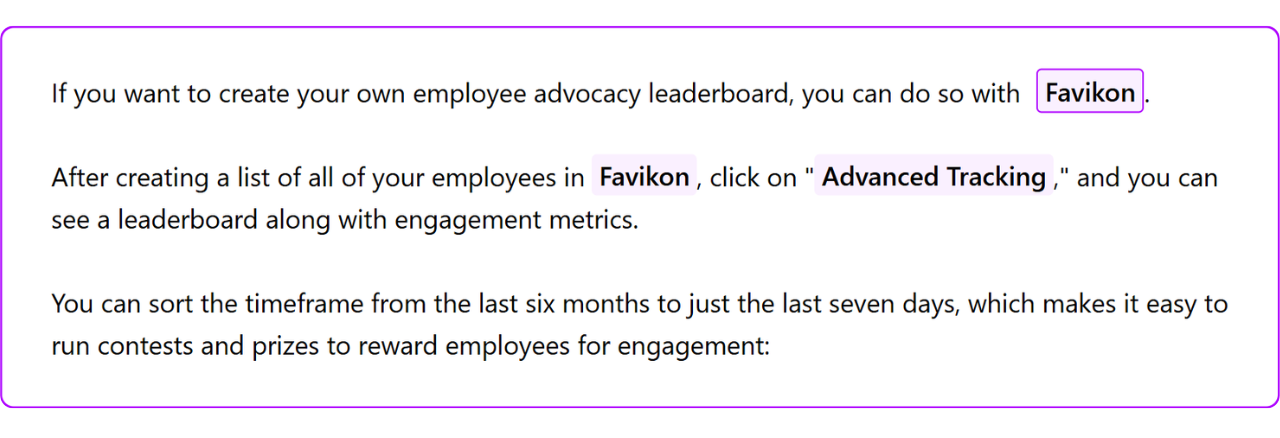
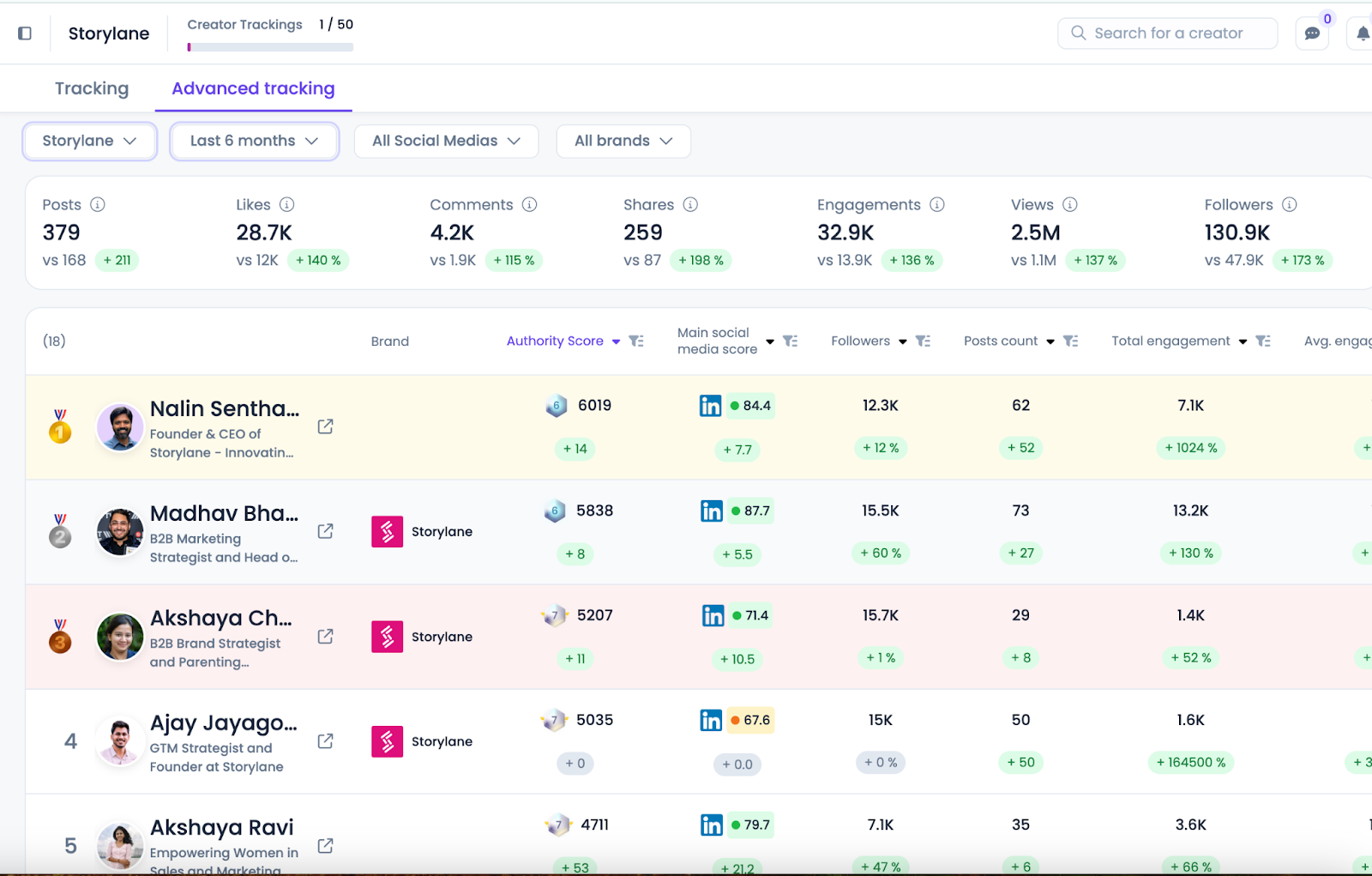
To recap, here are the main pillars of employee participation incentivization:
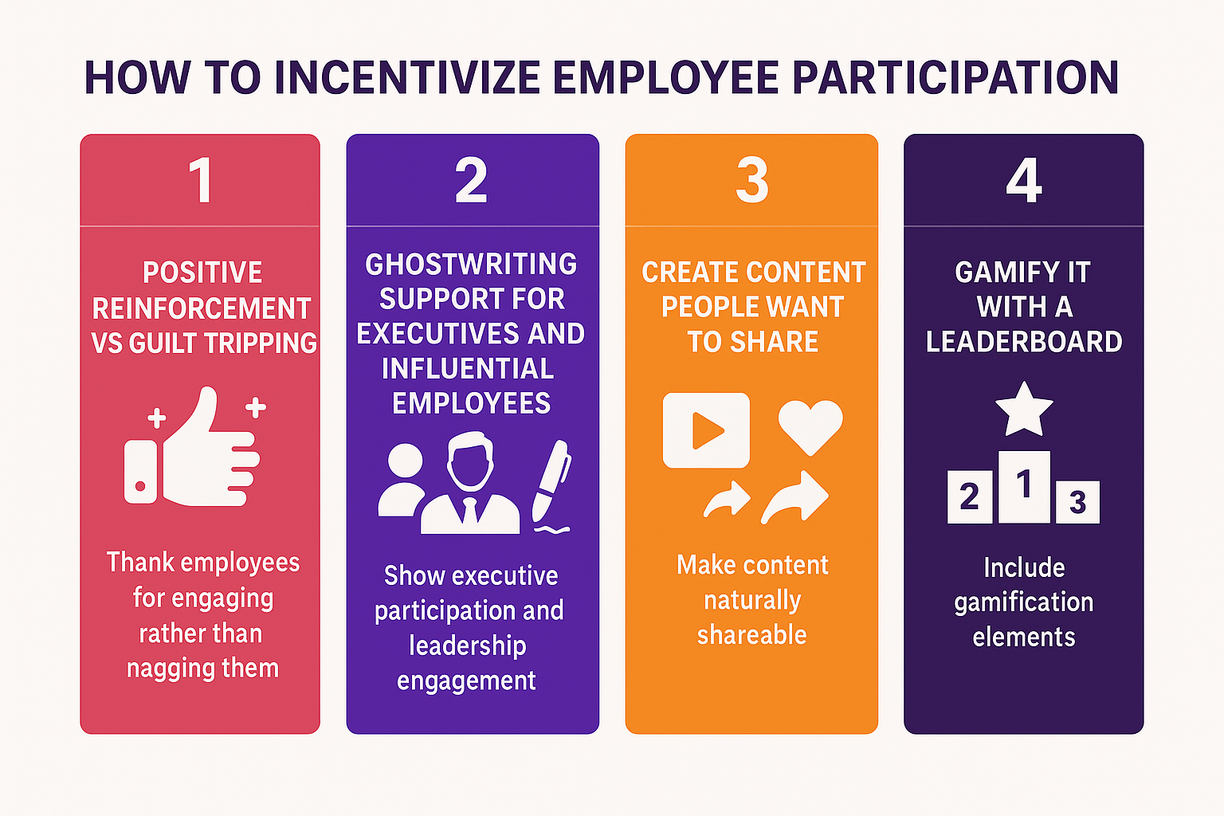
What: What should employees post?
Bhandari mentioned on the Ahrefs podcast that they’ll occasionally ask employees to promote new feature launches or company initiatives.
However, your employees won’t build an audience if they only promote company initiatives.
This means employees need to consistently post insightful content and build their own audience in order for your employee advocacy program to work.
This raises two questions:
- How do we ensure employees consistently post nonpromotional content that will perform well and build a following?
- What type of content performs well on LinkedIn and earns followers?
Starting with the first question, Storylane was fortunate to have a few LinkedIn-savvy employees who didn't need any help with topic ideation.
On the other hand, other employees didn’t know what to post or how to write an effective post.
To tackle this challenge, Storylane took an 80/20 approach and focused on assisting executives (rather than all employees).
Today, they have a single team member who brainstorms topic ideas and then listens to call recordings to ghostwrite LinkedIn posts.
This process ensures the posts are authentic to the executive, while also maintaining a consistent publishing schedule and ensuring the copywriting is well-optimized for LinkedIn.
Now let’s tackle the second question: What type of content performs well on LinkedIn and earns followers?
To answer this question, we looked at all of Storylane’s top performing posts from employees. Here’s a breakdown of them across categories:
Content Theme Analysis
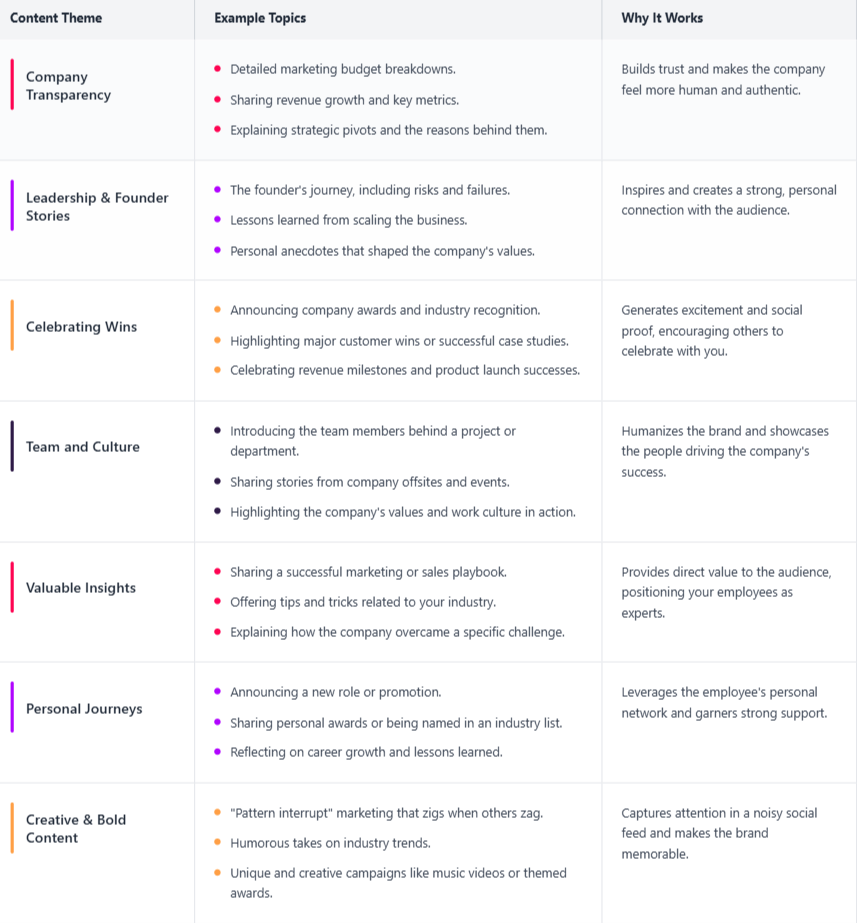

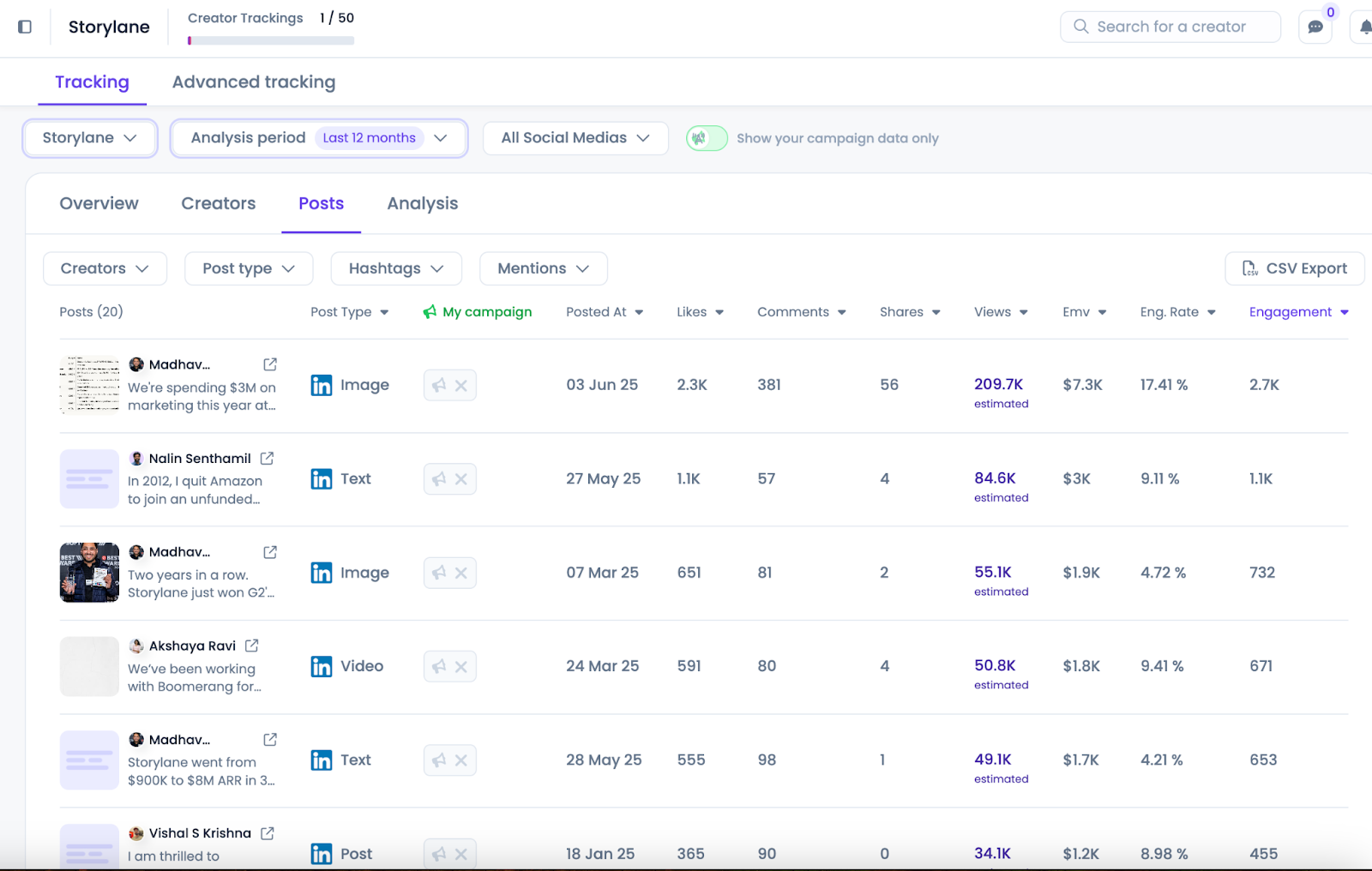
After scanning the data, you can see that the most successful posts are often transparency posts sharing data from Storylane’s own growth.
For example, this is the all-time highest performing post:
Bhandari wrote a post about why he’s an advocate for transparency content:
To summarize Storylane’s approach to employee advocacy, here’s a post directly from Bhandari:
Step 2: LinkedIn Influencer Marketing
The second-largest line item on Storylane's marketing budget is influencer marketing (and their Head of Brand confirmed that LinkedIn is the only platform they're investing in.)
Here are some stats:
- Over 700,000 monthly impressions
- $30 CPM vs $65 on other channels
If performance continues, they’ll likely push this budget to $1 million.
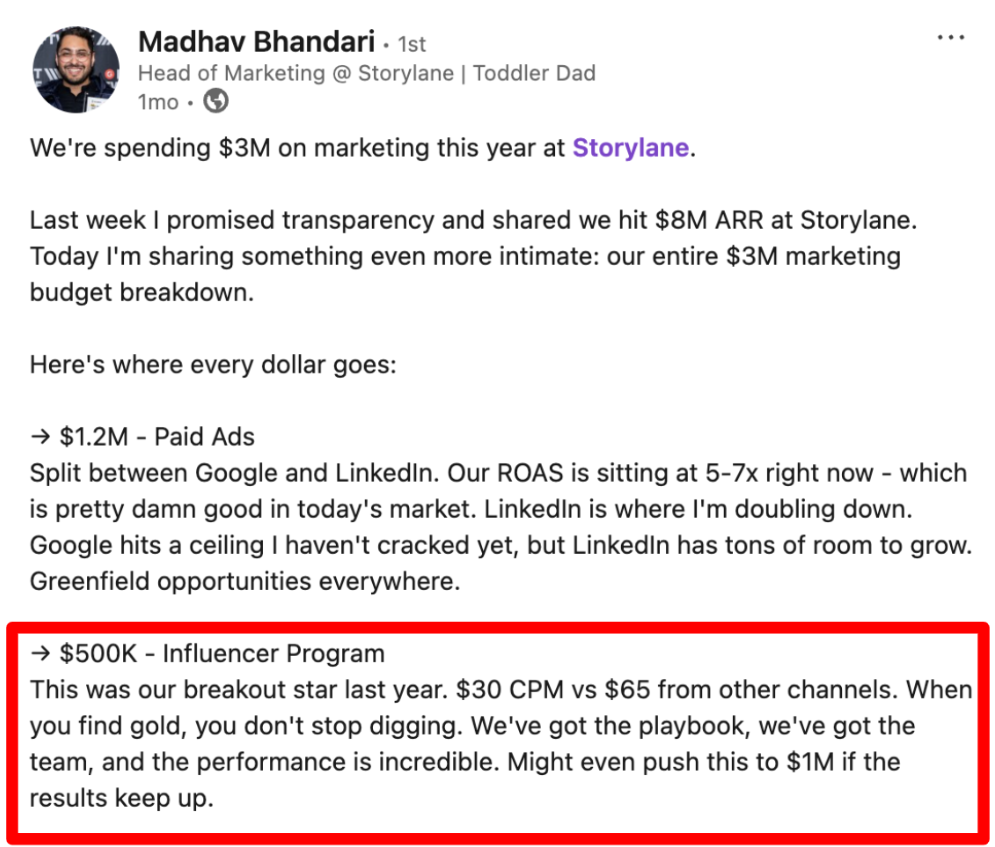
In a podcast episode on The RevRoom, Bhandari shared that they initially just asked customers to share their experience with Storylane on LinkedIn.

Seeking a more effective alternative to spark engagement, he looked into sponsoring LinkedIn creators.
As Bhandari wasn’t really sure where to start (or if “LinkedIn influencer marketing” was even a thing) he partnered with an agency to help them identify, contact, and negotiate with creators.
A few common questions that arise around LinkedIn influencer marketing are:
- Who do I partner with?
- How do I structure a partnership?
- What should people post?
- How do I measure success?
I analyzed every LinkedIn post Storylane sponsored, and using that data, we’ll explain how Storylane approached each of these questions.
#1. Who Storylane Partnered With
Since the initiation of their program, here are some stats I discovered on Favikon:
- Total creators involved: 12
- Total sponsored posts: 46
-


They hired creators with follower counts ranging from 8,384 followers to 97,871, though you can tell that there was very little correlation between follower count and engagement.
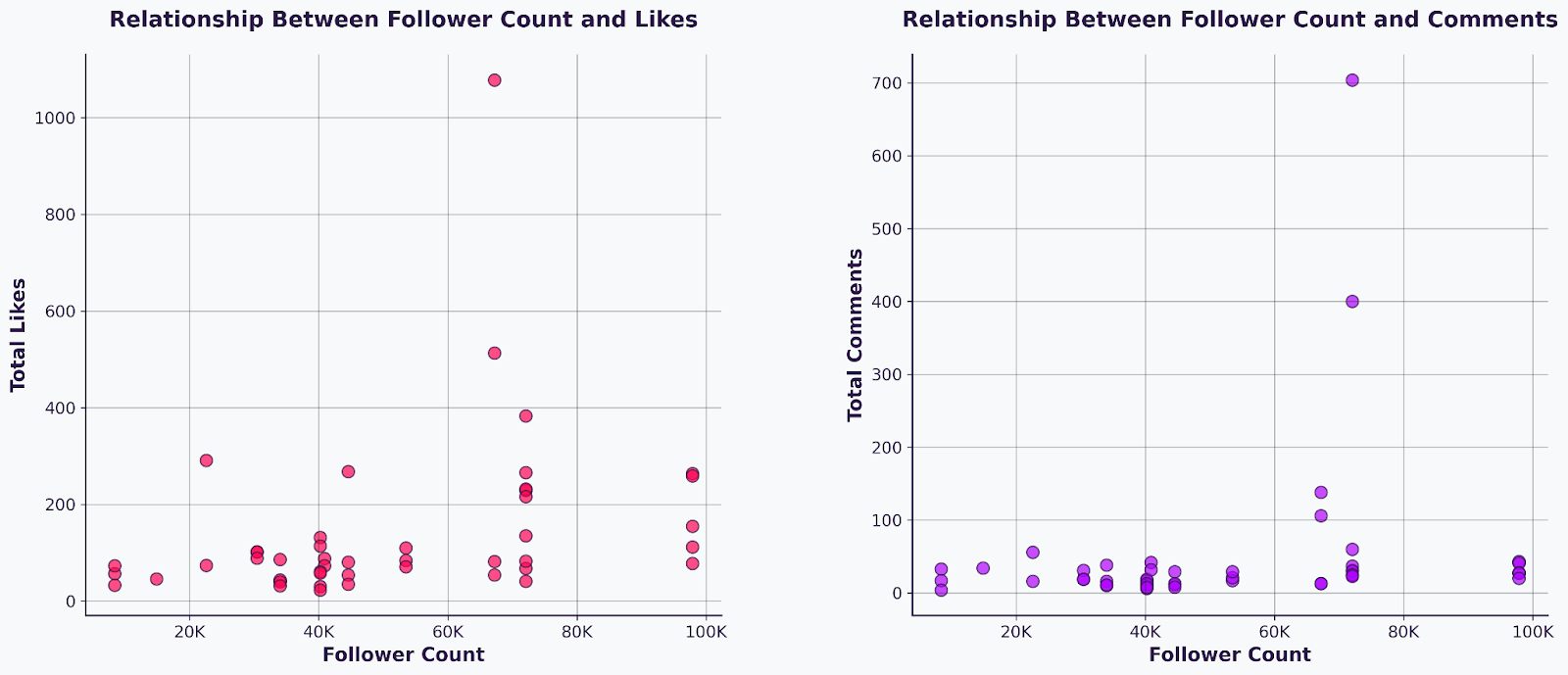
As their brand manager later mentioned, micro influencers often generated more engagement and generally produced a higher ROI:
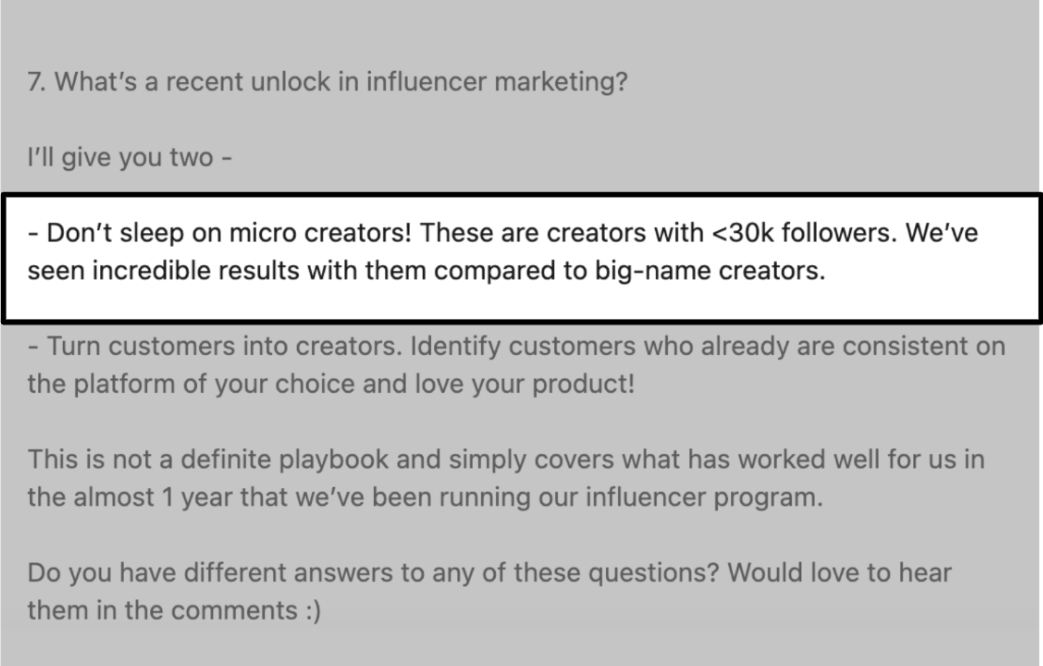
However, engagement and follower count aren’t the only factors to consider when selecting creators.
Creators have different levels of skill/experience, and it rarely correlates with follower count or average engagement.
Skill and experience are important considerations as they impact:
- Audience quality: High-level leaders tend to gravitate toward individuals with extensive industry experience.
- Depth of trust: People who speak from deep experience tend to have a higher level of trust with their audience as they have data to back their statements. This can translate to a higher conversion rate.
- Brand credibility: By associating your brand with genuine thought leaders, the brand also earns a reputation as an industry leader.
Storylane purposefully partnered with experienced sales and marketing leaders, even if they didn’t have a large audience.
Here are just a few of the leaders they partnered with:
- Sam Kuehnle: VP of Marketing at a Talent Intelligence Platform
- Anthony Natoli: Senior Account Executive @ LinkedIn
- Brian LaManna: AE @ Gong
These leaders all have genuine experience in sales and marketing.
Compared to, say, a sales intern who posts entertaining daily vlogs, these genuine experts likely have higher-quality audiences, and their message carries more weight.
Here’s a full criteria that their brand manager, Akshaya Chandramoul, mentioned in a LinkedIn post:
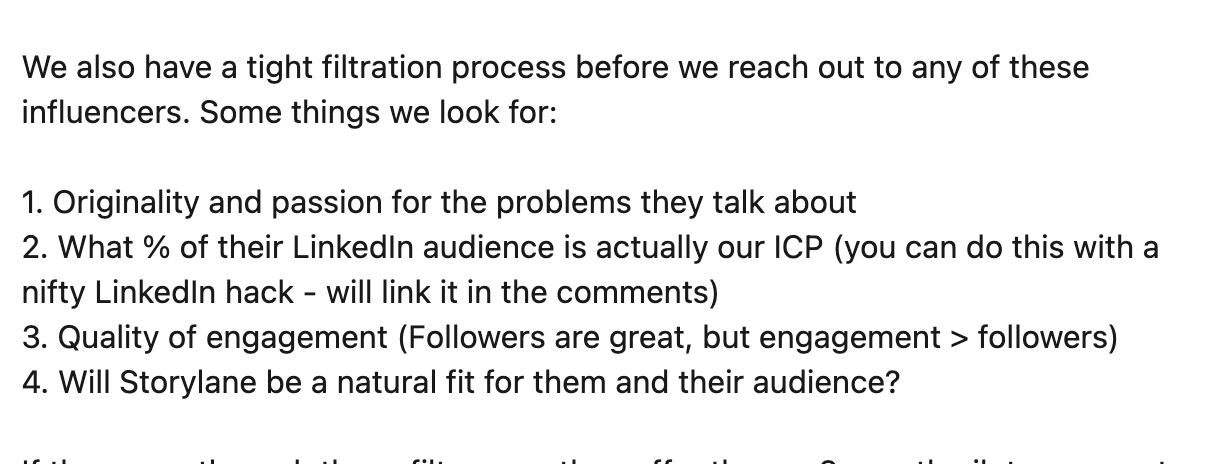
To find LinkedIn influencers, you can manually search on LinkedIn, ask for recommendations from creators and peers, or look at customers who already talk about your brand.
However, the creator discovery process can be tedious, and even after finding some promising creators, you'll have to manually vet:
- Engagement rate/follower count
- Average view per post
- Niche (e.g., marketing sales)
- Country (if you’re targeting an international market)
Even once you find a list of creators, reading through all of their content to determine the quality of the creator and their content is tedious.
The Authenticity score solves this problem.
It considers their followers, engagement quality, how often they use AI content, the content’s originality, and their genuine expertise.
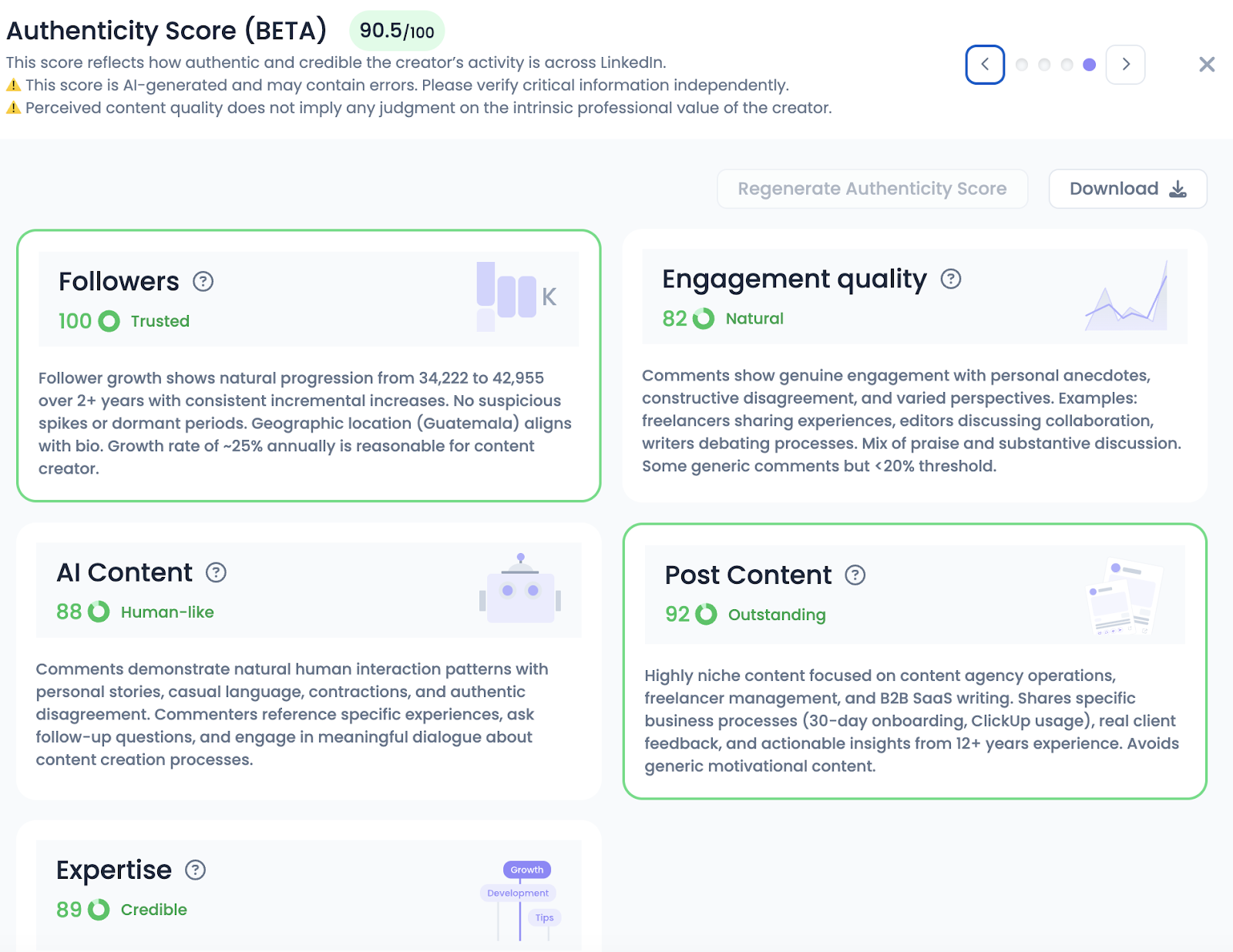
#2. How Storylane Structures Creator Partnerships
There’s also usually a debate between whether you should do long or short term partnerships with creators.
Hiring the same creator for the same post repeatedly may limit your total reach, but it can also improve the performance of each progressive post.
At Storylane, they prefer long term partnerships and always offer a 3-month pilot program to each creator.
One of Storylane’s partners, Tom Boston, recently posted this proving that each progressive post performed even better:
The next question most people ask is “How much should I pay for a creator?”
Brand manager, Chandramoul, stated in a LinkedIn post, “it’s still the wild west.”

One strategy is to simply ask a variety of influencers for rate cards.
However, receiving a response from creators is already hard enough, and I realize that blasting a lot of creators asking for rate cards isn’t ideal from a brand image standpoint.
To help you better estimate how much a LinkedIn creator will charge, Favikon collected sponsored post rate data from 136 LinkedIn influencers with 200 to 700,000 followers (yet about 90% had between 5,000 and 500,000 followers).
The prices varied from just $10 to $7,500 for a single post, though the majority (about 81%) fell between $200 and $2,000 per post.
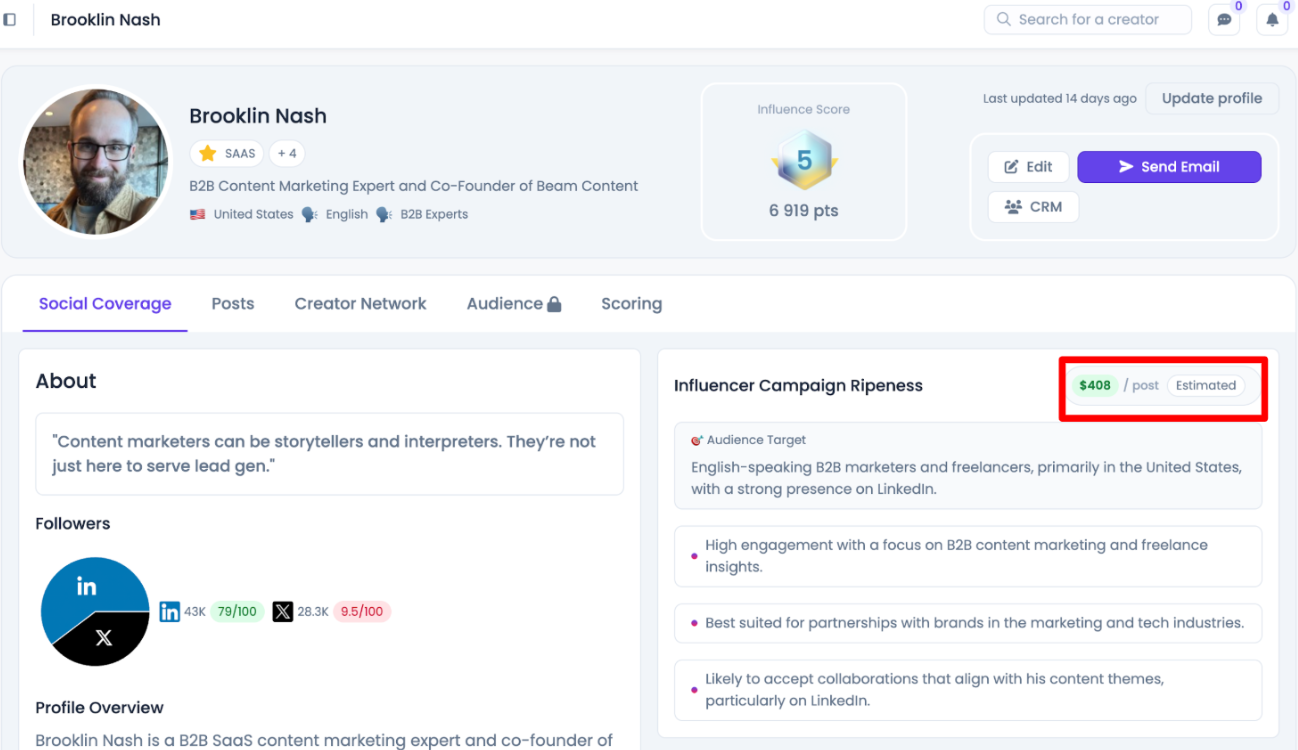
Based on that data, you’ll see sponsored post estimates inside each creator profile in Favikon. And, the score is calculated on not just their follower count, but also their authenticity score:
This estimate may not be perfect, but it at least gives you a ballpark figure of where to start the negotiation process.
#3. What Storylane’s Creators Posted
The type of content creators publish is arguably as important as who you hire to create content.
After analyzing Storylane’s 46 sponsored posts, I found that most of them could be categorized into the following buckets:
- Comedic short videos
- Product use cases/sales tips
- Content or live event promotion
- Other
Here’s a breakdown of how many sponsored posts fell into each category and the total engagements generated by each.
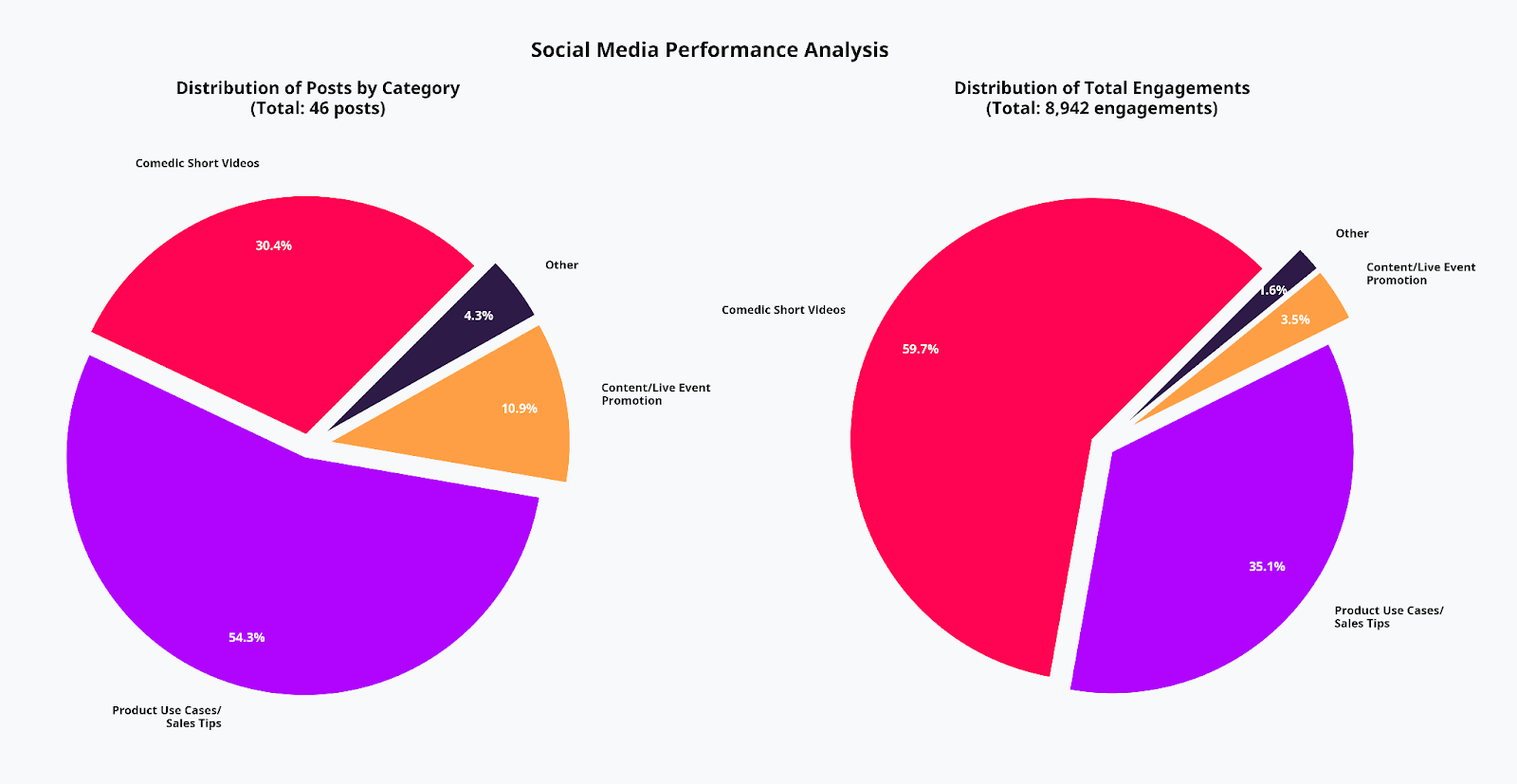
As you can see, the comedic posts garnered the most engagement, even though they accounted for only about 30% of the sponsored posts.
Nevertheless, engagement isn’t necessarily a perfect measurement of ROI (which we’ll discuss in more detail below).
Below, we’ll break down each category and give you examples of each type of post.
Comedic short videos
Even though these are all funny videos, the subject of each was highly relatable for sales professionals, and many of them have an underlying interesting point.
This is actually the highest performing post from an engagement perspective:
Product use cases/sales tips:
These product use case posts usually weave in Storylane.
Here’s one of the top performing “sales tips’ style of posts that includes a natural pitch for Storylane:
Here’s another slightly different style of a sales tip post that integrates the brand pitch:
Note: I noticed that some creators incorporated the product into the post much more elegantly than others, so consider offering creators a helping hand if they are struggling with the copywriting or product integration.
Content/event promotion:
Most brands are creating content, but very few are promoting it. Storylane realized that content alone isn’t valuable if nobody sees it, so they partnered with a few creators specifically to promote existing content.
For example, this creator promoted their Demo Kitchen series, which is essentially a series of case studies of creators using Storylane:
Additionally, Storylane invests heavily in live events and conferences, so they also hired creators to promote these events:
#4. How Storylane Measured Their LinkedIn Influencer Program
Attribution is hard.
Before sharing exactly how Storylane measured influencer marketing attribution, it’s helpful to hear some context on how Bhandari thinks about marketing attribution from a high-level perspective.
In the Ahrefs podcast, he shared that they think about it in three layers:
- Source of traffic: This is because any conversion activity ultimately happens on the website
- Form fill: How did you hear about us?
- Sales team asks: On sales calls, the sales team asks, and then they have a field in the CRM where they populate the responses
The goal here is to identify directional trends of sources most frequently cited, and it just so happens that one of the most frequently mentioned sources is LinkedIn.
He also emphasized that he cares more about who is seeing Storylane in their LinkedIn feed than how many people see Storylane.
“I don't necessarily care too much about, like, the number of impressions… You could get 100,000 impressions, but really, the decision makers are going to be 200, 300 [impressions].”
Now that you have more context for these decisions, here’s a concrete answer on how Storylane measures LinkedIn influencer marketing from their Head of Brand:
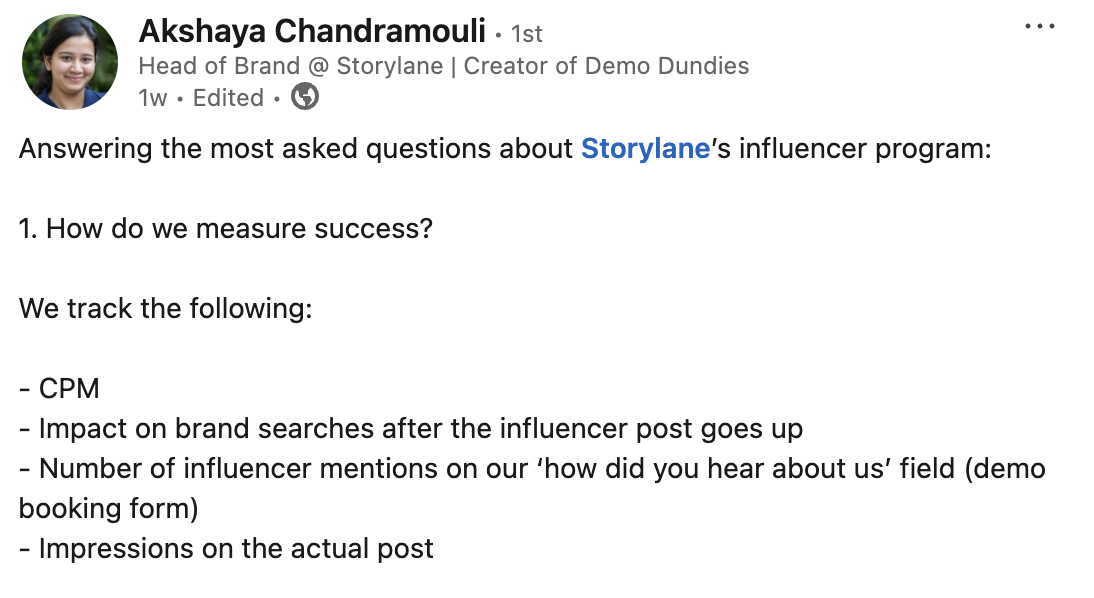
Step 3: LinkedIn Contests/Customer Led Content
Storylane’s initial idea to generate engagement on LinkedIn was customer advocacy – getting customers to post their use cases on LinkedIn.
While you could argue that this customer-led content initiative failed because none of Storylane’s customers had significant followings, it’s more likely due to a lack of incentive.
- Customers with engaged followings are often paid by brands to promote products to their audience. So why would they promote a brand for free?
- Customers had no incentive to put extensive effort into crafting a compelling post. Instead, they’re more likely to throw together a post in 5 minutes to appease the brand and move on with their day.
So, Storylane created a compelling incentive for customers to share their Storylane demos on LinkedIn: the Demo Dundies.
This initiative was a play on the Office Dundies. Users could submit their Storylane demo to a panel of judges and share it on LinkedIn using the hashtag #demodundies. The winner then received an all expenses paid vacation to Paris.
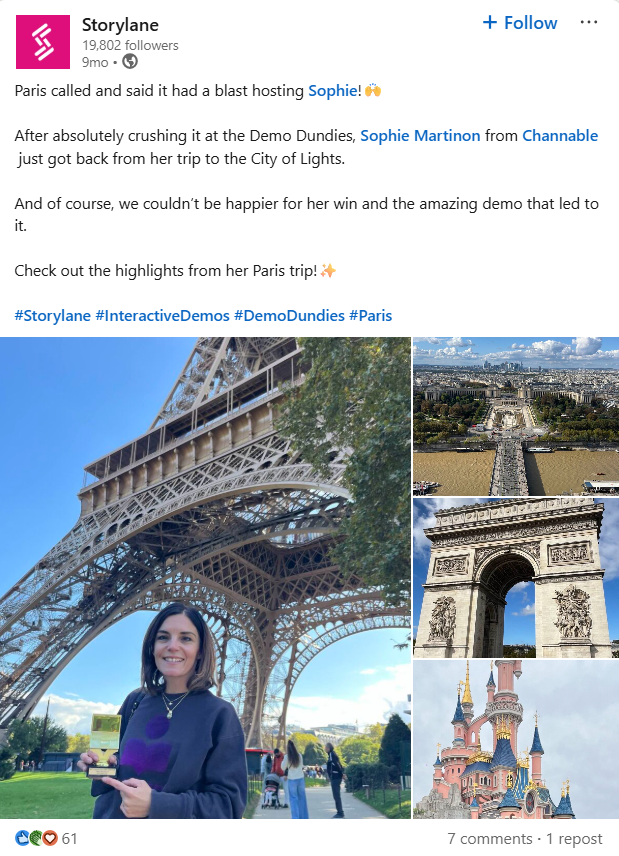
This content contest angle created a much more appealing incentive:
- Travel incentive: A free trip to Paris suddenly makes the contest much more appealing.
- Ego Bait: Winning a contest makes you look good in your company and it’s another great way to pad your resume.
These incentives increased participation (even LinkedIn influencers would likely find it worth their time to enter).
It also increased content quality because each person is more likely to put more than 5 minutes of effort into their post as they want to win a free trip to Paris.
The final layer that made the Demo Dundies highly successful was the Judges Panel.
Most of the judges were proud to announce that they would be on the panel, so they would also share about the contest, generating more brand awareness for Storylane.
While the team didn’t share exact statistics on campaign results, they recently announced that they’re running the program again:
And, Bhandari’s discussion of the program on the Ahrefs podcast illustrates that it was likely very successful.
How To Take Action and Build Your Own LinkedIn Marketing Strategy
More and more people are using LinkedIn to make purchase decisions, and they want to communicate with other people – not just brands.
Unfortunately, managing programs on LinkedIn is tricky as its API significantly restricts access, and very few platforms have figured out how to offer meaningful LinkedIn data.
Favikon identified this challenge and built a solution that is excellent for managing both employee advocacy and influencer campaigns.
From an employee advocacy perspective, here are just a few things you can do:
- Add all of your employees
- Track engagement in a leaderboard
- Monitor total team engagement and growth over time
From an influencer marketing perspective, here are just a few things you can do:
- Research creators with advanced filters like location, growth rate, niche, as well as general filters like follower count and engagement rates.
- Check the authenticity score of an influencer to evaluate the quality of their content (and following!)
- Add them to the CRM and manage campaigns directly in Favikon
- Monitor results
To see if Favikon is the right platform for your brand, you can try it out for free today.
Also See 👀
🏆 THE ULTIMATE GUIDE TO B2B INFLUENCER MARKETING
Related Articles
See all the articlesResources











.png)
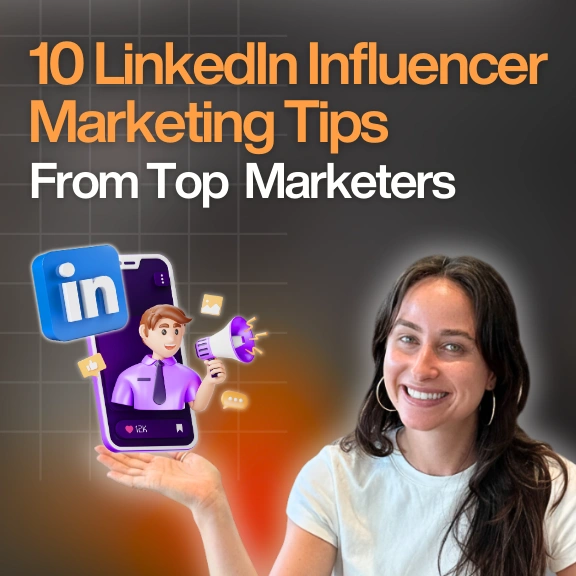




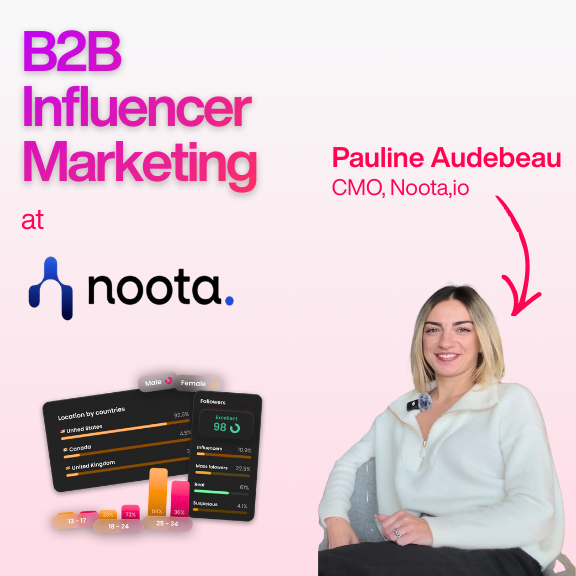


.png)


